Aligoté, Burgundy’s Other White Grape, Makes Its Case. A Selection From Eight Dedicated ‘Aligoteurs’, Produced in Chardonnay’s Heartland. (7-Bottle Pack $226)
Burgundy is so closely associated with two grape varities—Chardonnay for whites and Pinot Noir for reds—that any other ingredient on the FDA label looks jarring; possibly a typo. In fact, although 80% of Burgundy is planted to Chardonnay and Pinot Noir, the inclusive appellation ‘Bourgogne’ is also an occasional showcase for Gamay and Aligoté.
Bourgogne Aligoté is an AOP Régionale and Aligoté, like Chardonnay, Pinot Noir and Gamay, can also be used in the production of Crémant de Bourgogne.
This package represents several different incarnation of 100% Aligoté wine from several respected producers with whom we’ve had reliable and consistent results across the wine spectrum. The older vintages have been kept at optimal conditions and will demonstrate the amazing ability of well-made and properly-curated Aligoté to mature and evolve.
Burgundy’s Aligoté: A New Prospective
“Aligoté!” sounds like a cry of triumph; something you’d shout after making a goal in the World Cup. In fact, perennially overshadowed by its sexier cousin Chardonnay and even its half-sister Pinot Gris (they share a father, Pinot Noir), there was a time when the opposite was true:
“Before phylloxera,” says Jérôme Castagnier, proprietor of Domaine Castagnier in Morey-Saint-Denis, “Aligoté was planted everywhere, literally. But after the outbreak abated, thanks primarily to American root stock, French growers took stock and realized that Chardonnay and Pinot Noir commanded higher market prices, so that’s what was re-planted. In fact, in some regions, Aligoté was banned altogether.”
Post-phylloxera Aligoté exists under the basic Bourgogne Aligoté appellation established in 1937 and, for the most part, produces inexpensive and simple wines, especially when planted in the less-valued soils of the Saône Valley flatlands. But true Aligoté fans, including Les Aligoteurs (a group of French producers and wine lovers who promote Burgundy’s all-but-forgotten white grape variety) believe that the grape better expresses the terroir of thinner, rockier, hillside soils. A cross between Pinot Noir and the ancient white varietal Gouais Blanc, Aligoté’s profile includes descriptors ranging from fruit-driven and floral to herbal and sharp with acidity. In either case, it is the essential base for the classic cocktail Kir when blended with Cassis.
The grape is on full display in Bouzeron in the Côte Chalonnaise, which is a region that draws more interest from America than it does in its native France. Pockets of Aligoté exist throughout Burgundy, often on the fringes of the priciest real estate. It often presents itself as an ‘every day’ wine, and let’s raise a toast to that, since we have more ‘every’ days than we do special occasions. “Aligoté!”
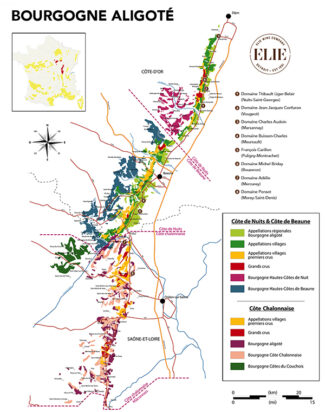
The offered 7-bottle package is comprised of one of each of the following wines at $226.
Côte de Nuits: A Few Remaining Enclaves
Any white wine from the Côte de Nuits is a bit of an outlier; the region, stretching north to south for a mere twelve miles and in places scarcely 700 feet wide, is noted for its plethora of Grand Cru, Pinot Noir-based reds. It is rightly thought of as the Champs-Elysées of Burgundy, with the output of winemaking being remarkably small compared to much of France: The average domain releases fewer than 1000 cases per year.
99% of Côte de Nuits’ vineyards are planted to Pinot Noir, and the few remaining enclaves of Aligoté make up around one-tenth of a percent. As such, remarkable for their rarity, it can generally be assumed that they are of exceptional quality.
Domaine Thibault Liger-Belair (Nuits-Saint-Georges)
Winemaking has been the legacy of Liger-Belair family for a quarter of a millennium. Prior to establishing his own domain, Domaine Thibault Liger-Belair studied oenology, worked for a communications firm in Paris and started an internet company to discover and sell high quality wines. Still, the vines beckoned, and in 2001, at the age of 26, he returned to them. The following year saw his first harvest of Nuits-Saint-Georges, and in 2003, he expanded into Richebourg Grand Cru, Clos Vougeot Grand Cru and Vosne-Romanée Premier Cru Petits Monts and in 2004, he discovered biodynamics, a train on which he has been a front-row passenger ever since:
“I saw a change in my vineyard, which went from gray soils to brown/red and then sometimes to black.” Still, his overarching philosophy is that each vineyard needs something different: “I don’t like 100% of anything: new barrels, whole clusters. My job is to decide which grapes we have and then decide a viticulture and winemaking approach.”
In 2018, he made wine from 23 different appellations and purchased grapes from a ten more, but did the work there. “We don’t purchase grapes where we don’t do the work,” he says.
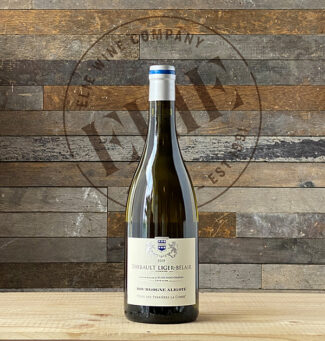 Domaine Thibault Liger-Belair ‘Clos des Perrières La Combe’, 2019 Bourgogne-Aligoté ($44)
Domaine Thibault Liger-Belair ‘Clos des Perrières La Combe’, 2019 Bourgogne-Aligoté ($44)
Located in an old quarry bordering the Village appellation Nuits-Saint-Georges Les Argilats (Vosne-Romanée side), the Aligoté grown in the climat ‘Clos des Perrières La Combe’’ sees six days of skin contact before a slow, seven-hour press. Vinification takes place in neutral barrels and produces an Aligoté replete with gorgeous texture and a ripe bouquet of orchard fruits in front of the grape’s signature minerality, which often comes across as saltiness.
Domaine Jean-Jacques Confuron (Vougeot)
The 20 acres that make up Domaine Jean-Jacques Confuron are now controlled by Sophie Meunier-Confuron and her husband Alain Meunier, who converted all parcels to organic viticulture in 1990. This includes excellent parcels of Premier Cru and Village vines in Vosne-Romanée, Chambolle-Musigny and Nuits-Saint-Georges as well as two great Grand Crus, Romanée-Saint-Vivant and Clos Vougeot.
The Confurons vinify according to the Burgundian mantra of ‘power without weight’, seeking a depth of flavor balanced by refinement and elegance. ‘Aux Plantes’ is a lieu-dit situated on clay-limestone soils that are ideally suited to Aligoté.
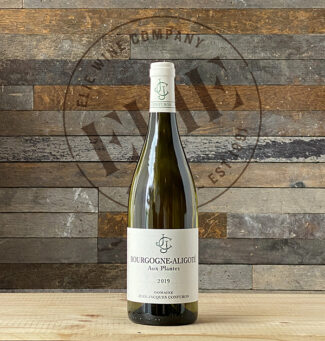 Domaine Jean-Jacques Confuron ‘Aux Plantes’, 2019 Bourgogne-Aligoté ($37)
Domaine Jean-Jacques Confuron ‘Aux Plantes’, 2019 Bourgogne-Aligoté ($37)
In order to preserve the freshness and tension inherent in the variety, the Aligoté used in the climat-specific wine from old vines lying on slopes with clay-calcareous soils. They are vinified in stainless steel vats and aged on lees without ever seeing oak. The wine shows a citrus basket of flavors along with notes of pear, green apple and hints of white flowers and raw honey.
Domaine Charles Audoin (Marsannay)
Charles Audoin was a true Burgundian visionary: He purchased premium land in Marsannay before it was even an appellation. Along with his enologist wife Marie-Françoise, he founded the domain in Marsannay-la-Côte in 1972, when it was a mere six acres planted chiefly to Gamay and Aligoté. In time, he expanded the holdings to cover 35 acres. His son Cyril is the fifth generation to join the family business, and continues his parents’ commitment to wines drawn primarily from single vineyards; his wines well-structured and wonderfully pronounced minerality and he believes that the estate offers among the best value in in the Côte de Nuits.
“I think it will be more difficult to change the image of Marsannay within Burgundy than internationally,” he says. “One problem is that Marsannay has been known since the 1930s for its rosé. That is part of the reason why Marsannay didn’t obtain its village appellation when the other villages did; when you are producing rosé you are not considered to be as serious as when you produce red or white. But rosé is part of our history, and ironically, the world today is producing more and more rosé while here in Marsannay, we are making less and less.”
 Domaine Charles Audoin, 2020 Bourgogne-Aligoté ($27)
Domaine Charles Audoin, 2020 Bourgogne-Aligoté ($27)
From organic 90-year-old vines which impart rich blend of scents, both floral and fruity—acacia blossoms and nectarine. The grapes undergo a cold soak prior to fermentation and are then transferred to neutral oak barrels. The mineral-driven palate echoes the aromatics, with peach and apple displaying bright acidity tempered by creaminess from the oak.
Côte de Beaune: Terroir For Red And White
Named after its principle town Beaune, the Côte de Beaune is Burgundy’s white wine powerhouse, with some of the world’s most expensive Chardonnay-based wines produced within its borders— a mere 16 miles from top to bottom. Most of these have ‘Montrachet’ attached to the names, in homage (and with financial savvy) to the region’s leading vineyard. But red wines also play a significant role in the region’s fame, particularly those from the Premier Cru vineyards of Pommard and the Grand Cru Corton.
Although becoming more than a blip on the world’s wine radar, Aligoté remains an afterthought, with fewer acres planted than Pinot Gris, which is permitted in the wines of most local appellations, even those specializing in red wines.
Domaine Buisson-Charles (Meursault)
Following the retirement of Michel Buisson in 2008, his daughter Catherine and her husband Patrick Essa rose to the occasion like grape skins in a fermenting batch of glory. The domain they inherited covers 30 acres, nearly all of it in Meursault. Their five parcels of Village-level vines, now average over 65 years old, while the oldest are nearing the century mark. There is a small parcel of Meursault Tessons, one of the great lieux-dits on the hillside above the southern half of the village, and there are tiny pieces of four exceptional Premier Crus. Only a few barrels of Charmes, Les Cras, Goutte d’Or and Bouches-Chères are produced each year.
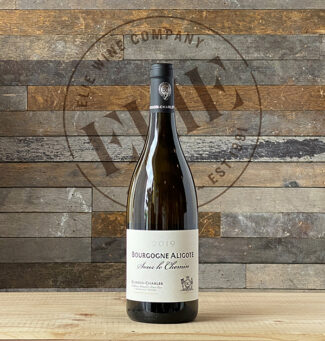 Domaine Buisson-Charles ‘Sous Le Chemin’, 2019 Bourgogne-Aligoté ($36)
Domaine Buisson-Charles ‘Sous Le Chemin’, 2019 Bourgogne-Aligoté ($36)
‘Sous Le Chemin’ is an Aligoté vineyard whose name means ‘under the path.’ The vines are 45 years old and produce wines marked by the style of the village of Meursault. In other words, the wine drinks more like a Chardonnay than the textbook image of Aligoté, heavier of expression and richly creamy. This is due in part to Essa’s experience with the former and his similar treatment of Aligoté, and also to the rich clay-limestone soil on which Le Chemin is planted. The wine has a complex nose of apple, honeycomb and floral notes while the palate oozes appealingly sappy fruit.
François Carillon (Puligny-Montrachet)
Although created in 2010, the family of François Carillon has been in the wine business for more than 500 years. The winery, in the heart of Puligny-Montrachet, is found among Burgundy’s most renowned white wine terroirs, sitting on forty acres of prized land in Puligny-Montrachet, Chassagne-Montrachet and Saint-Aubin. The estate produces from about seventeen (depending on the harvests) different appellations.
An adherent of ‘Lutte intégrée’, ploughing is done using horse or tractor and weed-killers are avoided. A strict pruning and de-budding regimen are followed as François does not green harvest.
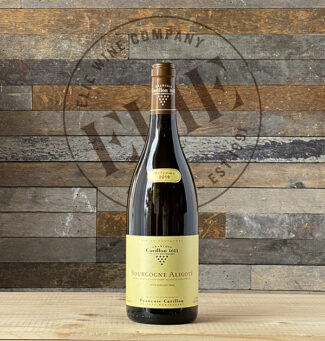 François Carillon, 2019 Bourgogne-Aligoté ($29)
François Carillon, 2019 Bourgogne-Aligoté ($29)
From vines over 50 years old in two plots, one in Puligny-Montrachet and the other in Corpeau to the south; the hand-harvested grapes are from an exceptional Aligoté clone, Jaune Doré. It is considered an Aligoté of a class higher than its reputation, with a rich, fleshy and lively palate showing grapefruit and tropical fruits with a long, mineral finish.
Côte Chalonnaise: The Golden Grape
Chalonnaise may be thought of as logical extension of the Côte de Beaune, lying just to the north of the hills of the Mâconnais. Côte Chalonnaise is 16 miles long by four wide and boasts a similar terroir overseen by hot, dry summers where grapes have no trouble ripening. As in most vineyards in Burgundy, Chardonnay and Pinot Noir predominate, but the ‘golden grape’ of one small hamlet is neither one: Bouzeron offers pride of place to Aligoté and is the only appellation Village that is entirely produced from this ancient variety.
Domaine Michel Briday (Bouzeron)
Domaine Michel Briday was founded in 1976 by Michel and Lucette Briday. Their original 15 acres has now grown to 38, spread across the municipalities of Rully, Bouzeron, and Mercurey. Under the management of Michel’s son and daughter-in-law, Stéphane and Sandrine, the domain has forged a reputation for producing Côte Chalonnaise wines with a superb quality to price ratio.
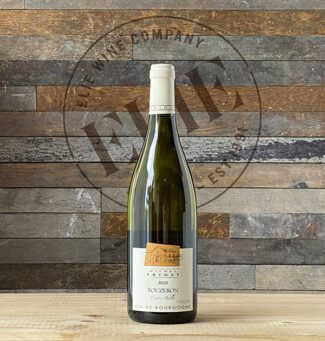 Domaine Michel Briday ‘Cuvée Axelle’, 2020 Bouzeron ($27)
Domaine Michel Briday ‘Cuvée Axelle’, 2020 Bouzeron ($27)
The domain manages four acres of 50-year-old Aligoté vines located at the top of a hillside where white marl soil is moderately deep but compact—ideally suited to the grape. Befitting ‘the golden grape of Bouzeron’, the wine shows sunny glints of yellow and Golden Delicious apple on the nose and palate with a warm glow of rain-damp stones in the finish.
Domaine Adélie (Mercurey)
Comprising 20 acres of various Mercurey lieux-dits (including the Premier Cru, Champ Martin), Domaine Adélie was named for the daughter of Albéric Bichot, lead négociant at the famous Hospices de Beaune and owner of five other prestigious estates in Burgundy. He was voted best winemaker by the International Wine Challenge in three of the past ten years.
With this recognition comes a commitment to sustainable agriculture and a reverence for the uniqueness of each parcel and its stewardship. Despite the accolades, Albéric downplays the grandeur of his hallowed vineyards, preferring to talk about wine as a beverage to be enjoyed with friends, not over-analyzed or intellectualized.
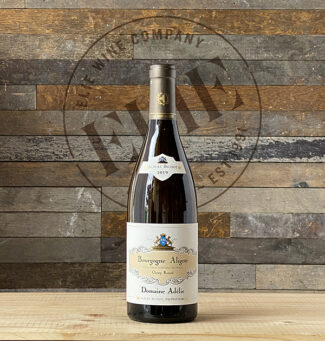 Domaine Adélie ‘Champ Renard’, 2019 Bourgogne-Aligoté ($26)
Domaine Adélie ‘Champ Renard’, 2019 Bourgogne-Aligoté ($26)
‘Champ Renard’ is a lieu-dit located at the entrance to Mercurey. The soils are sandy loam and clay/limestone. Bichot vinifies according to the same exacting standards he uses with Chardonnay; slow fermentation over six to eight weeks, then eight months in stainless. Fresh flavors of citrus and dried apples meld into a delicate nutty mid-palate nuanced by spice.
Giving Way To Terroir
The Parable of the Sower, in which a seed thrown on rocky ground withers while the one planted in fertile soil thrives, can be seen in reverse with Aligoté, which produces insipid and forgettable wine in fertile soil and shines with glory when planted on rocky hillsides.
But that’s a near-universal rule in winegrowing; an unhappy vine, forced to eke out a living and struggle for water and nutrients, produces concentrated grapes that lend themselves to complex wines. Productivity is the Holy Grail only of mass-production; limiting yields almost invariably creates wines of more distinction. Prices may rise accordingly, and sometimes extravagantly so. As always, finding the Goldilocks Zone where quality can be had at a reasonable tariff is the thrill of the hunt.
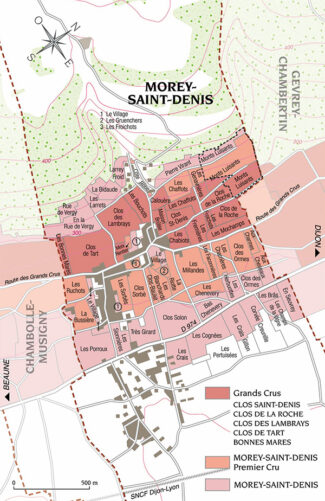
Domaine Ponsot (Morey-Saint-Denis)
In 1872, William Ponsot purchased a wine estate in Morey-Saint-Denis and set up shop by drawing fruit from parcels in the Clos des Monts-Luisants and Clos de la Roche. His nephew and godson Hippolyte Ponsot took over the domain in 1920 and by 1932 was bottling his entire harvest at the domain, a rarity for the time. Hippolyte’s son Jean-Marie succeeded him, followed by Jean-Marie’s children, Laurent and Rose-Marie. Today, Rose-Marie Ponsot is the sole director of the domain.
The winery is carved into the slope just north of the village of Morey-Saint-Denis, where gravity is utilized to move the must and wines. The exposed wall of the vat room provides a view of the limestone that makes up Burgundy’s roche mère, the mother rock that imparts character to its wine, including Ponsot’s Morey-Saint-Denis Clos des Monts Luisants ‘Vieilles Vignes’, a monopole made from 100%, much of which was planted in 1911 and the rest in 1930. It represents the only Premier Cru Aligoté produced in Burgundy.
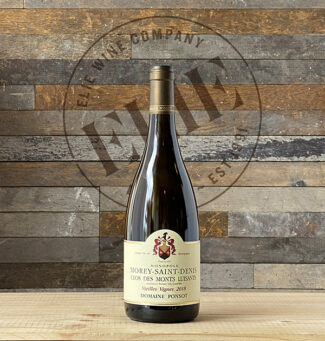 Domaine Ponsot ‘Vieilles Vignes’, 2018 Morey-Saint-Denis Premier Cru ‘Clos des Monts Luisants’ ($250) (Monopole)
Domaine Ponsot ‘Vieilles Vignes’, 2018 Morey-Saint-Denis Premier Cru ‘Clos des Monts Luisants’ ($250) (Monopole)
2018 was a warm vintage throughout Morey-Saint-Denis but the microclimate of Clos des Monts Luisants is much cooler than much of the appellation. Domaine Ponsot started picking on September 20, and winemaker Alexandre Abel reported yields some 35% to 40% below average, but the remaining fruit from the nearly three acres of vines from high on the Monts Luisants slope was superb. The wine shows both great ripeness and very fresh acidity behind polished aromas of dried white flowers and quince with a saline/mineral edge that mingles with beeswax and toasted almonds.
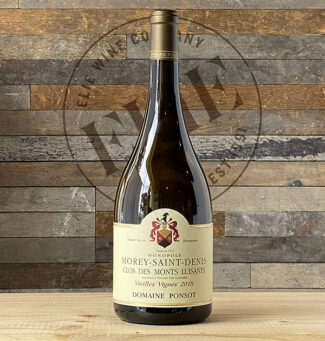 Domaine Ponsot ‘Vieilles Vignes’, 2018 Morey-Saint-Denis Premier Cru ‘Clos des Monts Luisants’ ($550) (Monopole) 1.5 Liter
Domaine Ponsot ‘Vieilles Vignes’, 2018 Morey-Saint-Denis Premier Cru ‘Clos des Monts Luisants’ ($550) (Monopole) 1.5 Liter
A Magnum version of the above wine, which will retain youthful exuberance longer and subsequently, mature at a slower pace.
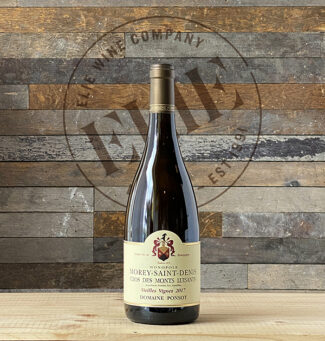 Domaine Ponsot ‘Vieilles Vignes’, 2017 Morey-Saint-Denis Premier Cru ‘Clos des Monts Luisants’ ($250) (Monopole)
Domaine Ponsot ‘Vieilles Vignes’, 2017 Morey-Saint-Denis Premier Cru ‘Clos des Monts Luisants’ ($250) (Monopole)
After a succession of lean years beset by hail, rot and frost, nature finally answered winemakers’ prayers in 2017, delivering a plentiful crop to equal or surpass the volumes achieved in the region’s last abundant vintage, 2009. After the gloom of 2016, a year ravished by the worst frosts since 1985, 2017 was a joy both in the fields and in the cellars. The wine shows crisp green apples, waxy citrus rind, orange oil and warm pastry. Fine-boned and elegant, it’s a chalky and incisive demonstration of the heights Aligoté can reach under careful management and planted to the right climat.
- - -
Posted on 2022.07.14 in Côte de Nuits, Nuits-Saint-Georges, Marsannay, Côte de Beaune, Puligny-Montrachet, Meursault, Vougeot, Côte Chalonnaise, Bouzeron, Mercurey, France, Burgundy, Wine-Aid Packages
Featured Wines
- Notebook: A’Boudt Town
- Saturday Sips Wines
- Saturday Sips Review Club
- The Champagne Society
- Wine-Aid Packages
Wine Regions
Grape Varieties
Aglianico, Albarino, Albarín Tinto, Albillo, Aleatico, Alicante Bouschet, Aligote, Altesse, Arcos, Aubun, Auxerrois, Barbarossa, Beaune, Biancu Gentile, Bonarda, bourboulenc, Cabernet Sauvignon, Caladoc, Carignan, Chablis, Chenin Blanc, Cinsault, Clairette, Cortese, Corvinone, Cot, Counoise, Dolcetto, Fiano, folle Blanche, Frappato, Fumin, Gamay, Garganega, Garnacha Tintorera, Godello, Graciano, Grenache, Grenache Blanc, Grolleau, Groppello, Jacquère, Lladoner Pelut, Maconnais, Malbec, Malvasia, Malvasia Nera, manseng, Marcelan, Marselan, Marzemino, Melon de Bourgogne, Mencía, Merlot, Mondeuse, Montepulciano, Montònega, Mourv, Mourvèdre, Muscadelle, Muscat, Natural, Nebbiolo, Nero d'Avola, Niellucciu, Palomino, Patrimonio, Pecorino, Pedro Ximénez, Persan, Petit Verdot, Pineau d'Aunis, Pinot Auxerrois, Pouilly Fuisse, Pouilly Loche, Poulsard, Riesling, Rondinella, Rose, Rousanne, Roussanne, Sagrantino, Sangiovese, Sauvignon, Sciacarellu, Serine, Souson, Sylvaner, Syrah, Tannat, Tempranillo, Teroldego, Timorasso, Treixadura, trepat, Trousseau, Ugni Blanc, Viognier, Viura, Xarel-loWines & Events by Date
- September 2025
- August 2025
- July 2025
- June 2025
- May 2025
- April 2025
- March 2025
- February 2025
- January 2025
- December 2024
- November 2024
- October 2024
- September 2024
- August 2024
- July 2024
- June 2024
- May 2024
- April 2024
- March 2024
- February 2024
- January 2024
- December 2023
- November 2023
- October 2023
- September 2023
- August 2023
- July 2023
- June 2023
- May 2023
- April 2023
- March 2023
- February 2023
- January 2023
- December 2022
- November 2022
- October 2022
- September 2022
- August 2022
- July 2022
- June 2022
- May 2022
- April 2022
- March 2022
- February 2022
- January 2022
- December 2021
- November 2021
- October 2021
- September 2021
- August 2021
- July 2021
- June 2021
- May 2021
- April 2021
- March 2021
- February 2021
- January 2021
- December 2020
- November 2020
- October 2020
- September 2020
- August 2020
- July 2020
- June 2020
- May 2020
- April 2020
- March 2020
- February 2020
- January 2020
- December 2019
- November 2019
- October 2019
- September 2019
- August 2019
- July 2019
- June 2019
- May 2019
- April 2019
- March 2019
- February 2019
- January 2019
- December 2018
- November 2018
- October 2018
- September 2018
- August 2018
- July 2018
- June 2018
- May 2018
- April 2018
- March 2018
- February 2018
- January 2018
- December 2017
- November 2017
- October 2017
- September 2017
- August 2017
- July 2017
- June 2017
- May 2017
- April 2017
- March 2017
- February 2017
- January 2017
- December 2016
- November 2016
- October 2016
- September 2016
- August 2016
- July 2016
- June 2016
- May 2016
- April 2016
- March 2016
- February 2016
- January 2016
- December 2015
- November 2015
- October 2015
- September 2015
- August 2015
- July 2015
- June 2015
- May 2015
- April 2015
- March 2015
- February 2015
- January 2015
- December 2014
- November 2014
- October 2014
- September 2014
- August 2014
- July 2014
- June 2014
- April 2014
- March 2014
- February 2014
- January 2014
- December 2013
- November 2013
- October 2013
- September 2013
- August 2013
- July 2013
- June 2013
- May 2013
- April 2013
- March 2013
- February 2013
- January 2013
- December 2012
- November 2012
- October 2012
Search



